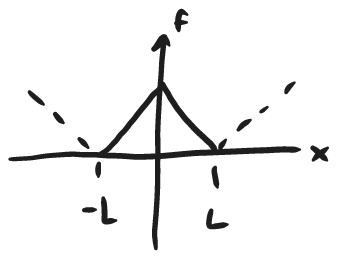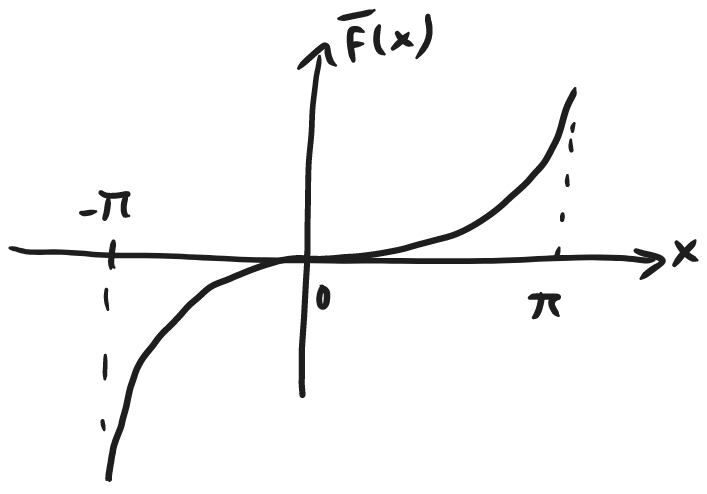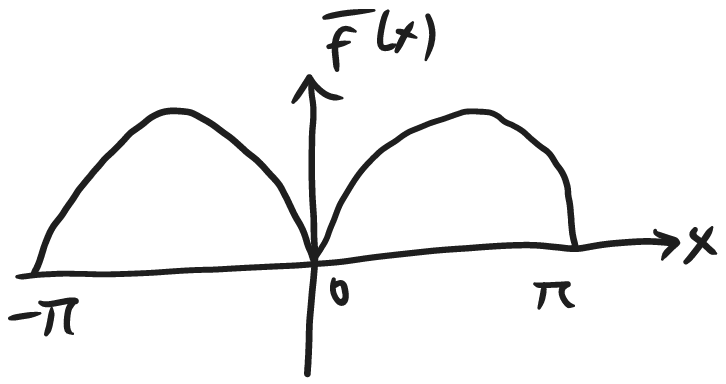13 KiB
#fourier Remember the heat flow equation? We obtained that it's solution could be expressed in the form:
\sum_{n=1}^\infty c_{n}\sin\left( \frac{n\pi x}{L} \right)\quad\text{for}\quad0\leq x\leq LBut what is c_{n}? They are the coefficients of a Fourier transform. We want to develop a way to compute them.
Let's derive how to compute the coefficients of a Fourier transform. (feel free to skip to the end)
f(x)=\sum_{n=1}^\infty b_{n}\sin\left( \frac{n\pi x}{L} \right) where L is length of the rod
This is a Fourier series: it's a more general form of what we have above.
f(x)=\frac{a_{0}}{2}+\sum_{n=1}^\infty\left( a_{n}\cos\left( \frac{n\pi x}{L} \right) + b_{n}\sin\left( \frac{n\pi x}{L}\right) \right)
x \in [-L,L]
It converges to f(x) almost everywhere (convergence will be discussed below)
Has a lot of benefits over Taylor series. f(x) doesn't have to be infinitely differentiable (analytic)
f(x) can even have jump discontinuities
Let's assume the equation is true when x \in [-L,L]
Integrate both sides, it will tell us the DC offset:
\int _{-L} ^L f(x) \, dx=\int _{-L}^L \frac{a_{0}}{2} \, dx+\int _{-L}^L (\text{put summation here}) \, dx
\int _{-L}^L \cos\left( \frac{n\pi x}{L} \right) \, dx=\frac{L}{n\pi}\sin\left( \frac{n\pi x}{L} \right)|_{-L}^L=0
same for \int _{-L}^L \sin\left( \frac{n\pi x}{L} \right)\, dx=0 (it equals 0)
so
\int _{-L} ^L f(x) \, dx=\int _{-L}^L \frac{a_{0}}{2} \, dx+\int _{-L}^L0 \, dx
\int _{-L} ^L f(x) \, dx=a_{0}L
a_{0}=\frac{1}{L}\int _{-L}^{L} f(x) \, dx
Now let's multiply both sides by \cos\left( \frac{m\pi x}{L} \right) and integrate both sides, this will tell us the \cos components:
\int _{-L}^L f(x)\cos\left( \frac{m\pi x}{L} \right)\, dx=\frac{a_{0}}{2}\cancelto{ 0 }{ \int _{-L}^L \cos\left( \frac{m\pi x}{L} \right) \, dx }+\sum_{n=1}^\infty\left( a_{n}\int _{-L}^L\cos\left( \frac{n\pi x}{L} \right)\cos\left( \frac{m\pi x}{L} \right) \, dx +b_{n}\int _{-L}^L \sin\left( \frac{n\pi x}{L} \right)\cos\left( \frac{m\pi x}{L} \right)\right) \, dx
use trig identities (will be provided on exam):
\cos(\alpha)\cos(\beta)=\frac{1}{2}(\cos(\alpha-\beta)+\cos(\alpha+\beta))
\sin(\alpha)\cos(\beta)=\frac{1}{2}(\sin(\alpha+\beta)+\sin(\alpha-\beta))
\sin(\alpha)\sin(\beta)=\frac{1}{2}(\cos(\alpha-\beta)-\cos(\alpha+\beta))
\int _{-L}^L \cos \frac{n\pi x}{L}\cos \frac{m\pi x}{L}\, dx=\frac{1}{2}(\int _{-L}^L \left( \cos(\frac{(n-m)\pi x}{L} )+\cancelto{ 0 }{ \cos(\frac{(n+m)\pi x}{L} })\right)dx
= \begin{cases}0 & n\ne m \\L & n=m\end{cases}
\int _{-L}^L \sin \frac{n\pi x}{L}\cos \frac{m\pi x}{L} \, dx=\int _{-L}^L \text{odd}\, dx=0
so:
\int _{-L} ^L f(x)\cos\left( \frac{m\pi x}{L} \right)\, dx=a_{m}L
Similarly can be done for when multiplying both sides by \sin\left( \frac{m\pi x}{L} \right) and integrating both sides to find the \sin coefficients:
\int _{-L}^L f(x)\sin\left( \frac{m\pi x}{L} \right)\, dx=\frac{a_{0}}{2}\cancelto{ 0 }{ \int _{-L}^L \sin\left( \frac{m\pi x}{L} \right) \, dx }+\sum_{n=1}^\infty\left( a_{n}\cancelto{ \text{odd} }{ \int _{-L}^L\cos\left( \frac{n\pi x}{L} \right)\sin\left( \frac{m\pi x}{L} \right) } \, dx +b_{n}\int _{-L}^L \sin\left( \frac{n\pi x}{L} \right)\sin\left( \frac{m\pi x}{L} \right)\right) \, dx
\int _{-L} ^L \sin\left( \frac{n\pi x}{L} \right)\sin\left( \frac{m\pi x}{L} \right) \, dx=\frac{1}{2}\int_{-L}^L \cos\left(\frac{(n-m)\pi x}{L} \right)-\cos\left( \frac{(n+m)\pi x}{L} \right)dx
=\begin{cases}0, & n\ne m \\L, & n=m\end{cases}
so:
\int _{-L} ^L f(x)\sin\left( \frac{m\pi x}{L} \right)\, dx=b_{m}L
In conclusion:
a_{m}=\frac{1}{L}\int _{-L}^L f(x)\cos \frac{m\pi x}{L} \, dx \quad\text{valid for all }m=0,1,2,\dotsb_{m}=\frac{1}{L}\int _{-L}^L f(x)\sin \frac{m\pi x}{L} \, dx=b_{m} \quad m=1,2,\dotsNow we know how to compute the coefficients for Fourier series!
properties:
for functions f, g, If \int _{-L}^Lf(x)g(x) \, dx=\begin{cases}0 & f\ne g \\L & f=g \end{cases}
then f, g are orthogonal
the Fourier expansion is called an ortho normal expansion, Taylor is not orthonormal.
#end of lec 28
#start of lec 29
Last lecture we derived how to find the coefficients of a Fourier series.
f(x)=\frac{a_{0}}{2}+\sum_{n=1}^\infty\left( a_{n}\cos\left( \frac{n\pi x}{L} \right) + b_{n}\sin\left( \frac{n\pi x}{L}\right) \right)
x \in [-L,L]
1st convergence theorem:
If f and f' are piecewise continuous on [-L,L], then the Fourier series converges to:
\frac{1}{2}(f(x^-)+f(x^+)) for all x \in (-L,L)
and on x=\pm L the Fourier series converges to \frac{1}{2}(f(-L^+)+f(L^-))
 Recall the definition of piecewise continuous:
Recall the definition of piecewise continuous: f(t) is piecewise continuous on an interval I if f(t) is continuous on I, except possibly at a finite number of points of jump discontinuity (horizontal asymptotes not allowed).
2nd Convergence theorem (uniform convergence):
If f(x) is continuous on (-\infty,\infty) and 2L periodic and if f' is piecewise continuous on [-L,L], then its Fourier series converges to f(x) everywhere (i.e., the Fourier series converges uniformly).
 #ex #fourier
Let's compute the Fourier transform of:
#ex #fourier
Let's compute the Fourier transform of:
f(x)=\begin{cases}1, & -\pi\leq x\leq 0 \\x, & 0<x\leq \pi\end{cases}L here is \pi clearly.
Let's find the coefficients a_{n} and b_{n}
Use the formula we derived earlier:
a_{n}=\frac{1}{\pi}\left( \int _{-\pi}^0 1\cos\left( \frac{n\pi x}{\pi} \right)\, dx +\int _{0}^\pi x\cos(nx)\, dx\right)
Using integration by parts (for the second integral):
=\frac{1}{\pi}\left( \frac{1}{n}\cancelto{ 0 }{ \sin(nx) |_{-\pi}^0} + \frac{1}{n}x\cancelto{ 0 }{ \sin(nx) |_{0}^\pi}-\frac{1}{n}\int _{0}^\pi \sin(nx) \, dx \right)
a_{n}=\frac{1}{n^2\pi}(\cos(nx)|_{0}^\pi)=\frac{1}{n^2\pi}(\underbrace{ \cos(n\pi) }_{ (-1)^n }-1)
a_{n}=\frac{1}{n^2\pi}((-1)^n-1)\quad n=1,2,\dots
Now let's find b_{n}
b_{n}=\frac{1}{\pi}\left( \int _{-\pi}^0\sin(nx) \, dx+\int _{0}^\pi x\sin(nx) \, dx \right)
=\frac{1}{\pi}[ \frac{-1}{n}\underbrace{ \cos(nx)|_{-\pi}^0 }_{ 1-(-1)^n }-\frac{1}{n}( \underbrace{ x\cos(nx)|_{0}^\pi }_{ \pi(-1)^n-0 }-\underbrace{ \int _{0}^\pi \cos(nx)\, dx }_{ 0 } ) ]
b_{n}=\frac{1}{n\pi}((-1)^n-1-\pi(-1)^n)
b_{n}=\frac{1}{n\pi}((-1)^n(1-\pi)-1) \quad n=1,2,\dots
we find that
a_{2n}=0 \qquad n=1,2,3,\dotsa_{2k-1}=-\frac{2}{n^2\pi} \qquad k=1,2,3\dotswhat about when n=0?
a_{0}=\frac{1}{\pi}\left( \int _{-\pi}^0 \, dx+\int _{0}^\pi x \, dx \right)
a_{0}=\frac{1}{\pi}\left( x|_{-\pi}^0+\frac{x^2}{2}|_{0}^\pi \right)
a_{0}=\frac{1}{\pi}\left( 0+\pi+\frac{\pi^2}{2} \right)
a_{0}=\frac{\pi}{2}+1#ex Let's compute the Fourier transform of:
f(x)=x \qquad -\pi\leq x\leq \piWe have to take a windowed form of f to make this possible, L=\pi
At the left and right edge of the interval, the Fourier series is equal to 0. (1st convergence theorem.)
Find the coefficients:
a_{n}=\frac{1}{\pi}\int _{-\pi}^\pi x\cos(nx) \, dx=0
a_{n}=0Why is it zero? because the integrand is an odd function. (odd times even is odd.) and because we are integrating from -\pi to \pi (a symmetric interval)
definition of odd: f(x)=-f(-x)
definition of even: f(x)=f(-x)
odd times even is odd.
odd times odd is even.
even times even is even.
huge exam time saving technique.
Find b_{n}:
b_{n}=\frac{1}{\pi}\int _{-\pi}^\pi x\sin(nx) \, dx=\frac{2}{\pi}\int _{0}^\pi x\sin(nx) \, dx <- that's even, don't be a silly goose and say it's 0
Using integration by parts:
b_{n}=\frac{2}{\pi}\left( x\left( -\frac{1}{n}\cos(nx)|_{0}^\pi \right)-\int_{0}^\pi -\frac{1}{n}\cos(nx) \, dx \right)
b_{n}=\frac{2}{\pi}\left( -\frac{\pi}{n}(-1)^n+\frac{1}{n^2}\cancelto{ 0 }{ \sin(nx)|_{0}^\pi } \right)
b_{n}=\frac{2}{n}(-1)^{n+1}another take away: if f is odd, the \cos terms are 0
if f is even, the \sin terms are 0.
if f is only defined between 0 and L:
you can create an odd extension: \bar{f}(x)=\begin{cases}f(x) & 0\leq x\leq L \\-f(-x), & -L\leq x<0 & & \end{cases}
this will contain only \sin terms.
You also have a choice to extend it as an even function, symmetrically across the y axis.
\bar{f}(x)=\begin{cases}f(x) & 0\leq x\leq L \\f(-x), & -L\leq x<0 & & \end{cases}
This will contain only \cos terms.
#end of lec 29
#start of lec 30
From last lecture:
f(x) is defined on [0,L]
odd extension:
\bar{f}(x)=\begin{cases}f(x), & 0\leq x\leq L \\-f(-x,) & -L\leq x<0\end{cases}
and the a coefficients (\cos terms) are zero.
not only that, but the b coefficients are:
b_{n}=\frac{1}{L}\int _{-L}^L\bar{f}(x) \sin\left( \frac{n\pi x}{L} \right) \, dx
b_{n}=\frac{2}{L}\int _{0}^L f(x)\sin\left( \frac{n\pi x}{L} \right)\, dxand \bar{f}(x) is:
\bar{f}(x)=\sum_{n=1}^\infty b_{n}\sin\left( \frac{n\pi x}{L} \right)"How about that, this is called a Fourier sine series."
For even extension:
\bar{f}(x)=\begin{cases}f(x), & 0\leq x\leq L \\f(-x,) & -L\leq x<0\end{cases}
and the b coefficients (\sin terms) are zero.
not only that but the a coefficients are:
a_{n}=\frac{1}{L}\int _{-L}^L\bar{f}(x) \cos\left( \frac{n\pi x}{L} \right) \, dx
a_{n}=\frac{2}{L}\int _{0}^L f(x)\cos\left( \frac{n\pi x}{L} \right)\, dxand \bar{f} is:
\bar{f}(x)=\frac{a_{0}}{2}+\sum_{n=1}^\infty a_{n}\cos\left( \frac{n\pi x}{L} \right)Remember that \sum_{n=1}^\infty b_{n}\sin\left( \frac{n\pi x}{L} \right) was the expansion of the eigen value function from the heat equation?
then \frac{a_{0}}{2}+\sum_{n=1}^\infty a_{n}\cos\left( \frac{n\pi x}{L} \right) is also an expansion of some related eigen value function. It's interesting to note.
#ex #fourier Fourier sine series for:
f(x)=x^2 \qquad 0\leq x\leq \piWell that means we want the odd extension:
 the
the a_{n} (cosine) terms are zero.
the b_{n} terms are:
b_{n}=\frac{2}{\pi}\int _{0}^\pi x^2\sin(nx) \, dx
=-\frac{2}{n\pi}\left[ x^2\cos(nx)|_{0}^\pi-2\int _{0}^\pi x\cos(nx)\, dx \right]
=-\frac{2}{n\pi}\left[ \pi^2(-1)^n-\frac{2}{n}\left( x\cancelto{ 0 }{ \sin(nx) }|_{0}^\pi-\int _{0}^\pi \sin(nx)\, dx \right) \right]
b_{n}=-\frac{2}{n\pi}[ \pi^2(-1)^n-\frac{2}{n^2}\underbrace{ \cos(nx)|_{0}^\pi }_{ (-1)^n-1 }]=\frac{2\pi}{n}(-1)^{n+1}+\frac{4}{n^3\pi}((-1)^n-1) for n=1,2,3,\dots
Note no n=0 so no division by zero problems here.
#ex #fourier Fourier cosine series of f(x)=\sin(x) for 0\leq x\leq \pi

b_{n} (sine) terms are all zero obviously, as it's asking for a Fourier cosine series, i.e., we are doing an even extension.
a_{n}=\frac{2}{\pi}\int _{0}^\pi \sin(x)\cos(nx)\, dx for n=0,1,2,\dots <-Odd, but not symmetrical bounds. We can't rule out that it's zero.
Don't be a silly goose and try changing the bounds by removing that 2 in the front. If you did, you'd also have to change
\sin(x)to\bar{f}which isabs(\sin(x))and then you're integratinga_{n}=\frac{1}{\pi}\int _{-\pi}^\pi |\sin(x)|\cos(nx)\, dxwhich is even$\times$even.
Use trig identity: (by the way the identities will be provided in the final exam.)
=\frac{2}{\pi} \frac{1}{2}\int _{0}^\pi \left[\sin((1-n)x)+\sin((n+1)x)\right]\, dx
Integrating gives you:
\frac{1}{\pi}( \frac{-1}{1-n}\underbrace{ \cos((1-n)x)|_{0}^\pi }_{ (-1)^{n+1}-1 } +\frac{-1}{n+1}\underbrace{ \cos((n+1)x)|_{0}^\pi }_{ (-1)^{n+1}-1 })
a_{n}=-\frac{1}{\pi} \frac{1}{n+1}(-1)^{n+1}+\frac{1}{\pi} \frac{1}{n+1}+\frac{1}{\pi} \frac{1}{-(1-n)}(-1)^{n+1}+\frac{1}{\pi} \frac{1}{1-n}
a_{n}=-\frac{1}{\pi} \frac{1}{n+1} (-1)^{n+1}+\frac{1}{\pi} \frac{1}{n+1}+\frac{1}{\pi} \frac{1}{n-1}(-1)^{n-1}-\frac{1}{\pi} \frac{1}{n-1}
Assuming that n\ne0,1. (note: n=-1 is a non-issue since negative coefficients are never considered when taking a Fourier transform.)
So what is a_{0}, a_{1}?
a_{0}=\frac{2}{\pi}\int _{0}^\pi \sin(x) \, dx=\frac{4}{\pi}
a_{1}=\frac{2}{\pi}\int _{0}^\pi \sin(x)\cos(x) \, dx=\frac{1}{\pi}\int _{0}^\pi \sin(2x)\, dx=0
"zero is a very very special number it took humanity many numbers of years to invent zero" referring to when dividing by 0.
Additionally we know that the terms cancel when:
a_{2k-1}=0 for k=1,2,\dots
a_{2k}=\frac{2}{\pi} \frac{1}{2k+1}-\frac{2}{\pi} \frac{1}{2k-1} for k=1,2,\dots
then:
\bar{f}(x)=\frac{2}{\pi}+\frac{2}{\pi}\sum_{k=1}^\infty\left( \frac{1}{2k+1}-\frac{1}{2k-1} \right)\cos(2k\pi x)Even with 10 terms, we get a pretty good approximation:
 Here's a little script that generates an audible waveform of this Fourier series!
Here's a little script that generates an audible waveform of this Fourier series!
</head>
Play the sound
Number of harmonics:
Frequency:
We have prepared ourselves now, now we start solving PDE's. He's encouraging us to attend the lectures in these last two weeks. He's making it sound like PDE's are hard.